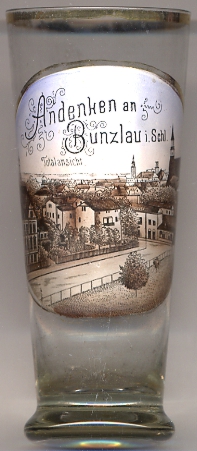

|
| POLSKA | POLAND |
| województwo: Dolnośląskie | voivodship: Lower Silesia |
| powiat: Bolesławiec | county: Bolesławiec |
 Bolesławiec (in German: Bunzlau) is situated at an elevation of 190 m on the Bóbr (Bober) river in the voivodship Lower Silesia of Southwestern Poland,
about 100 km west of Wrocław, the voivodship's capital. Bolesławiec is the administrative seat of Bolesławiec County and of
Gmina (rural district) Bolesławiec, although it is not part of the territory of the latter, the town being an urban gmina in its own right.
Between 1975 and 1998 Bolesławiec was part of the voivodship Jelenia Góra. Bolesławiec has a population of about 40,000 (2012).
Bolesławiec (in German: Bunzlau) is situated at an elevation of 190 m on the Bóbr (Bober) river in the voivodship Lower Silesia of Southwestern Poland,
about 100 km west of Wrocław, the voivodship's capital. Bolesławiec is the administrative seat of Bolesławiec County and of
Gmina (rural district) Bolesławiec, although it is not part of the territory of the latter, the town being an urban gmina in its own right.
Between 1975 and 1998 Bolesławiec was part of the voivodship Jelenia Góra. Bolesławiec has a population of about 40,000 (2012).
The name Bolesławiec is derived from the Silesian duke Bolesław I the Tall. The castellany of Bolezlauez in Lower Silesia was first
mentioned in a 1201 deed. According to tradition, its citizens took part in the Battle of Legnica during the Mongol invasion of Poland in 1241.
Following the 1241 invasion, a walled town began to take shape. In 1251, mention is made of Bolesławiec's town charter. Then a part of the Silesian Duchy of Legnica
under Bolesław II the Bald, the town from 1297 belonged to the Duchy of Jawor under Bolko I the Strict. In 1316, in order to better protect the townspeople
from hostile incursion, new walls were constructed around the town. The city seal, still used today, was also first used in 1316.
In 1346, the town joined seven other urban centers in forming the Silesian Association of Fortified Towns.
In that same year, the Duchy of Jawor with Bolesławiec was inherited by Duke Bolko II the Small of Świdnica, and upon his death in 1368, it was inherited by
Emperor Karl IV, who had married Duke Bolko's niece Anna of Świdnica. The town became part of the Kingdom of Bohemia, itself a state of the Holy Roman Empire.
The year 1422 was of particular importance, because in that year, the town was granted beer-brewing privileges.
1523 marked the start of the religious wars between Catholics and Protestants, with the majority of the town's residents converting to the new faith — Bunzlau
became an important center of the Protestant Reformation. A post station was established in 1573. In 1596, Bunzlau found itself a stop along the new Via Regia trade route
connecting Breslau (Wrocław) with Leipzig.
In 1642, during the Thirty Years' War, Bunzlau was pillaged by Swedish forces, which reduced the castle, church, and much of the housing to ruins. After the First Silesian War in 1742,
the town, along with most of Silesia, found itself in the expanding Prussian Kingdom. From 1815 onwards, Bunzlau belonged to the Prussian Province of Silesia. The demolition of the
old ring of defensive walls began around 1820, allowing for the physical expansion of the town out from its medieval center.
The Second World War left the town some 60% in ruins. Silesia east of the Oder-Neisse line was annexed by the Republic of Poland. The German population was exiled and replaced by
Polish refugees from Poland's former eastern territories as well as by Polish repatriates from Yugoslavia and France.
[http://en.wikipedia.org/wiki/Bolesławiec, https://de.wikipedia.org/wiki/Bolesławiec]
|
Other places with similar names of which glasses are in this collection are:
Stará Boleslav (CZ) (Altbunzlau) Mladá Boleslav (CZ) (Jungbunzlau) |
![[scale]](lineal.jpg)